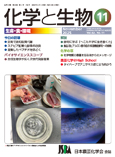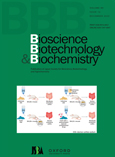[on May 22, 2021]
Visionary NOUGEIKAGAKU 100
Symposium (2) on Food Function Research Area: Elucidation of new functionality of food ingredients obtained from new discoveries and ideas ~ for getting the novel insight ~
Date & venue; Online on May 22, 2021
1. Food components modulate mRNA splicing
Seiji Masuda, Department of Food Science and Nutrition, Faculty of Agriculture, Kindai University
Food-derived flavonoids, apigenin and luteolin, modulate mRNA splicing at the genome-wide level followed by inhibition of cell proliferation. mRNA splicing regulatory activity was relatively modest, but affected various types of alternative splicing including intron retention. Among introns, introns with weak splice sites tend to become targets of them. Intracellular targets were splicing-related factors, implicating that they modulate splicing by binding directly to splicing factors. These results illustrate a possible mechanism by which food-derived compounds regulate alternative splicing. The fact that food components can alter gene expression by regulating splicing of various genes is an attractive milestone for the future of functional foods and offers the possibility that daily intake of moderate splicing regulators can prevent uncontrolled cell growth such as cancer development.
2. G-protein coupled receptor-mediated signaling of gut microbial metabolites
Junki Miyamoto, Applied Biological Chemistry, Graduate School of Agriculture, Tokyo University of Agriculture and Technology
Excessive food consumption and an unbalanced diet cause metabolic syndrome such as obesity and related metabolic disorders. Over the past decade, the gut microbiota has emerged as an essential mediator in obesity and related metabolic disorders. Gut microbiota is affected by diet, and macronutrients are used as substrates by gut microbiota for produced metabolites, such as short-chain and long-chain fatty acids, that may modulate host energy homeostasis. These free fatty acids are not only essential energy sources but also signaling molecules via G-protein coupled receptors (GPCRs). Some GPCRs have a critical for metabolic functions, such as hormone secretion and inflammation in various types of cells and tissues, and contribute to energy homeostasis. The recent advances show the mechanisms whereby the gut microbiota modulates the effects of diet and shapes the host metabolism either towards or away from obesity and related metabolic disorders.
3. Studies on mechanisms underlying development of AAA, and establishment of preventive method by functional food factors
Nobuhiro Zaima, Department of Applied Biological Chemistry, Faculty of Agriculture, Kindai University
Abdominal aortic aneurysm (AAA) is a vascular disease which is characterized by a gradual dilation of abdominal aorta. Increased dilation of AAA often result in the rupture of AAA with high mortality. At present, no pharmaceutical drugs are available for AAA. We previously found the possibility of hypoperfusion in human AAA wall caused by the obstruction of vasa vasorum, microvessel in aortic wall. Reconstruction of hypoperfusion in the rat aortic wall resulted in the formation of AAA, which suggest the close relationship between aortic hypoperfusion and the development of AAA. We next found the abnormal appearance of adipocytes in AAA wall can cause AAA rupture both in human and the experimental AAA model animal. These findings of AAA-related factors made us possible to investigate the relationship between AAA and food. We found some functional food factors can prevent the development of AAA, which might show the possibility of prevention of AAA by functional food factors.
4. Zinc absorption and zinc physiology; The roles of zinc transporters
Taiho Kambe, Division of Integrated Life Science, Graduate School of Biostudies, Kyoto University
Zinc is indispensable for all living organisms. It plays a pivotal role as a structural, catalytic, and regulatory component within protein functions in numerous and varied biological responses. As it has a wide range of physiological functions, zinc deficiency causes various symptoms, such as taste disorders, dermatitis, decreased appetite, growth disorders, and more. Approximately 20–30% of the Japanese population is estimated to be zinc deficient. Thus, its prevention is important for human health. In zinc absorption in the intestinal tract, two zinc transporters, ZIP4 and ZNT1, play pivotal roles. Since zinc absorption is approximately 30%, and the absorption rate decreases with increasing zinc intake, improving intestinal zinc absorption using dietary components may be an effective strategy to prevent zinc deficiency. We found a soyasaponin Bb was effective in promoting the cell surface expression of ZIP4, which consequently contributes to increases in the cellular zinc levels. Food-derived factors like a soyasaponin Bb would be effective in improving zinc nutrition.
5. New functional compounds in Miso – Pyroglutamyl peptides and monoamines
Kenji Sato, Division of Applied Biosciences, Graduate School of Agriculture, Kyoto University
Miso is prepared using Aspergillus sojae or A. oryzae starter (koji) with strong protease activity. Thus, miso is rich in free amino acids and short chain peptides. These compounds can be chemically and enzymatically modified during aging process. Some pyroglutamyl peptides such as pyroGlu-Leu ameliorated high fat diet-induced obesity in rat at 0.1-1 mg/kg body weight. It also ameliorated high fat diet-induced disturbance of rat gut microbiota by increasing host antimicrobial peptide (α-defensin) into lumen. High fat diet feeding also decreased liver GAPDH and increased toxic methylglyoxal, which is generated from substrate of GAPDH. Miso contains phenethylamine, which can suppress the decrease of GAPDH and increase of methylglyoxal at 10 µg/kg body weight. The effective dose of these compounds can be obtained by normal consumption of miso (approximately 3 cups of miso soup), which suggests that daily consumption of miso and other Japanese fermented foods can impact human health.
6. Development of high-purity human-type ceramide derived from traditional Japanese brewing technology and its practical application
Tatsurou Ueki, Research & Development Department, Fukukoka Soy sauce Brewing Cooperation
Soy sauce cake contains about 0.1% ceramide. Ceramide derived from soy sauce cake was the same molecular type of ceramide (consisting mainly of phytosphingosine and its derivatives) as that found in human epidermis. In the text, this ceramide is referred to as human-type ceramide. A parallel, double-blind, placebo-controlled study (21 adults) was conducted to verify the effect of a lotion containing 0.05% human-type ceramide on skin. The results showed that lotion containing ceramide derived from soy sauce cake inhibited transdermal water evaporation. In addition, a parallel, double-blind, placebo-controlled study (42 adults) of a supplement containing 2 mg of human-type ceramide showed a reduction in fatigue. Human-type ceramide derived from soy sauce cake is a material that can be used in both cosmetics and food, and supplements and cosmetics containing this material have been developed. Soy sauce cake is used as cattle feed, and the residue after ceramide extraction can be used as cattle feed as well.












































